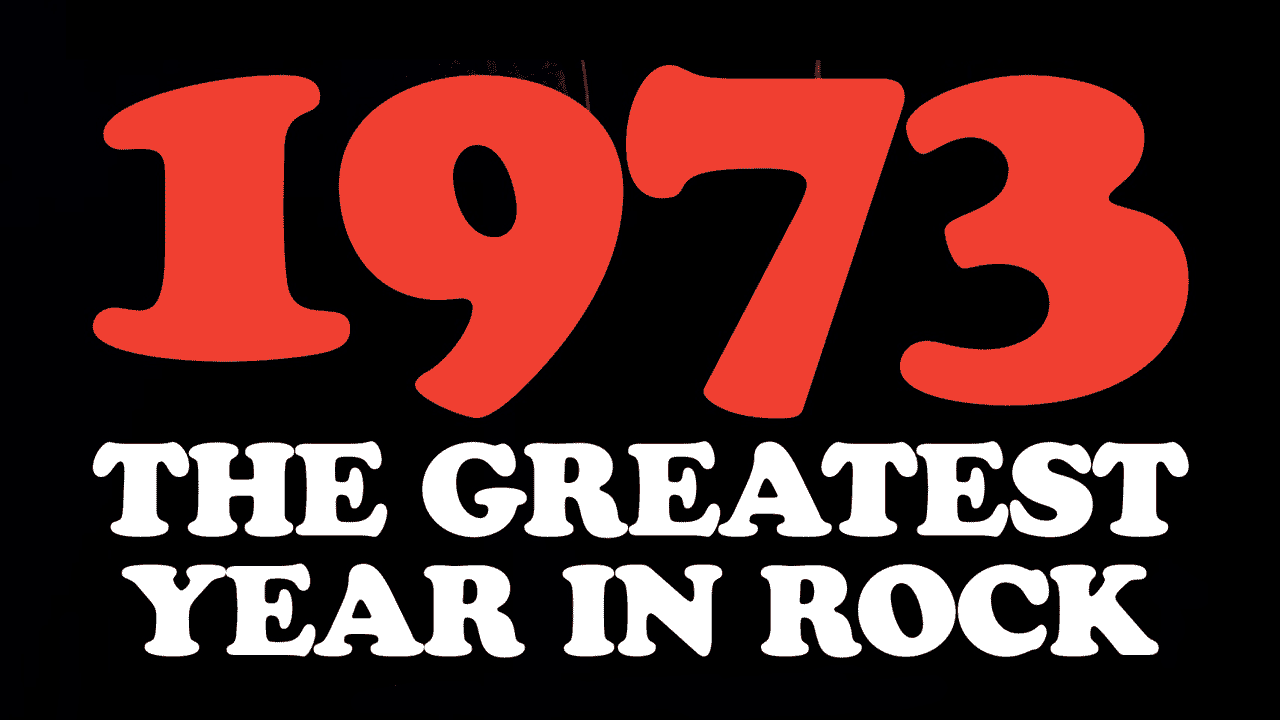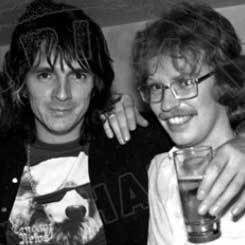Imagine a year that saw the release of Led Zeppelin’s Houses Of The Holy, Pink Floyd’s The Dark Side Of The Moon and Alice Cooper’s Billion Dollar Babies. That would be one extremely big year for rock’n’roll music, for sure.
A little further down the scale, envisage a 12- month time-span that also saw Roxy’s Music’s For Your Pleasure, Bruce Springsteen’s Greetings From Asbury Park, NJ and Derek & The Dominoes’ In Concert hit the stores.
And, mounting a determined rearguard action, picture a 365-day period during which the likes of The Doobie Brothers’ The Captain & Me, King Crimson’s Larks’ Tongues In Aspic and T.Rex’s Tanx additionally went on sale.
One helluva year, we think you’ll agree. And if you haven’t worked it out by now, we’re talking about nineteen hundred and seventy-three. Yep, it was such a fabulous year it deserves to be spelled out in full. But here’s the rub. Prepare to step back in amazement, get set to prod your peepers in surprise, because every single one of the above-mentioned albums – Houses Of The Holy, Dark Side Of The Moon, Billion Dollar Babies et al – actually came out in a single month in 1973.
March, to be specific. It doesn’t stop there. The other 11 months of 1973 were pretty damn good as well.
- January gave us Free’s Heartbreaker
- February offered Deep Purple’s Who Do We Think We Are!, the final studio offering from the Mk II lineup (at least until the 1984 reunion)
- April brought us David Bowie’s Aladdin Sane
- May set Mike Oldfield’s Tubular Bells a-chimin’
- June – another killer month, this – saw both Aerosmith’s Aerosmith and Iggy & The Stooges’ Raw Power go on sale
- July’s undoubted highlight was the release of Queen’s first album, Queen
- In August The New York Dolls’ self-titled debut hit the stores
- September was no slouch with Status Quo’s Hello!, Lynyrd’s Skynyrd’s Pronounced Leh-Nerd SkinHerd, The Rolling Stones’ Goats’ Head Soup and Thin Lizzy’s Vagabonds Of The Western World fighting for shelf space.
- Genesis were intent on Selling England By The Pound in October
- The Who brought mods to the masses with Quadrophenia in November
- And Black Sabbath’s Sabbath Bloody Sabbath finished the year on the loudest of notes
Sheesh. No wonder we were so skint all those years ago. We were all were spending our hard-earned money on a huge number of soon-to-be-legendary albums!
We at Classic Rock often have discussions about which was The Greatest Year In Rock. It’s the kind of office banter that gets us through the day. And we admit there are more obvious candidates for The Greatest Year In Rock than 1973. For example:
- 1967: for the Summer Of Love and all that
- 1976: for being the year when the punk rock revolution gobbed off
- 1979: for being when the New Wave Of British Heavy Metal was born
- 1987: for being when hair metal reached its peak
- 1991: for being when Nirvana’s Nevermind and Pearl Jam’s Ten came out, forcing hundreds of hapless glam-rock bands to batten down their beauty parlours for all time (or at least until the Rocklahoma festival was introduced)
And so on. Bands and artists have also admitted to a particular affection for a specific year in the lyrics and titles of their albums and songs.
- Bryan Adams and Iggy & The Stooges decided to commemorate 1969
- The Clash, unsurprisingly, professed a fondness for 1977
- David Bowie was captivated by Orwell’s megagloomy vision of life in 1984
- Prince wanted to party like it was 1999
- Going further back in time, Bob Dylan got all misty-eyed about the Days Of ’49, The Who waxed lyrical about 1921, and Motörhead found themselves slam-bang in the middle of the Great War in 1916
Hmm. Not much mention of 1973 so far. Not unless you include a song by Australian new wavers Mental As Anything, which contains the following winsome words: ‘Now the stony lights are humming And we’re filing out the door I hope these kinds of nights keep running ’Cause I’ll be coming back for more and more It was 1973, it was 1973, it was 1973…’
No, we don’t remember what the hell it sounds like, either. Anyhow, going back to those aforementioned office discussions, and regardless of those other years’ claims of supremacy, 1973 has always had vociferous support as The Greatest Year In Rock among a strong Classic Rock contingent.
Then, just the other day, we received a reader’s letter from Bill, who lives in the romantic-sounding location of Land O’ Lakes, Florida, that really piqued our interest.
Bill (sorry, mate – we can’t tell what your surname is from your scribbled signature) wrote: "With all the music and information available today, I am surprised no one has acknowledged 1973 as the best ever year in music."
"Now that’s a mighty bold statement," he continued, "and one that would cause fists to fly and tempers rage out of control. "But, before you burn an effigy that resembles you-know-who, hear me out. Then you can light your matches."
In a lengthy diatribe that followed, Bill mounted a very convincing argument for 1973 to be regarded as a year like no other. The Greatest Year In Rock, in fact. And let’s face it, we needed something to cheer us up. The year of 1973 kicked off with the United Kingdom entering the European Economic Community, later to become the European Union, and it went downhill rapidly from there. The FA Cup final was between Sunderland and Leeds, fer Chrissakes.
Meanwhile, over in the States – as our man Bill reports – "it was the era of the eight-track tape and leisure suits, paisley shirts and sideburns, platform shoes, wide ties and Skylab.
"We had acid rock, baroque rock, country rock, dance, glam rock, hard rock, heavy metal, head music, hot-rod music, reggae, jazz, bubblegum, funk and southern rock."
In other words, it was a sizzling musical melting pot back in the day. Creativity was rife and artistic control was paramount. Bands and artists weren’t dictated to by record companies. They were masters of their own destinies. If you were a mighty, muscle-flexing outfit such as Floyd, Zep or The Who, you delivered your albums to your labels as faits accompli.
These epic pieces of work weren’t the subject of marketing focus groups or reality TV shows like the The X Factor or American Idol. No, they were the product of bold visionaries. Or, as Todd Rundgren put it in 1973, wizards and true stars.
Few people questioned Emerson, Lake & Palmer when they came up with an album with the unlikely title of Brain Salad Surgery, complete with a bizarre cover by HR Giger, who was later to find fame designing the evil ET in the Alien movies. No one batted an eyelid when Messrs Mercury, May, Deacon and Taylor decided to call themselves Queen and include a track called My Fairy King on their debut album. (These were also more innocent, better times, remember.) The Sweet – who admittedly had suffered from a fair degree of record company puppetry – broke free from their bubblegum past and included all-out rockers such as Hell Raiser, Blockbuster and Done Me Wrong Alright on their 1973 self-titled album.
The Beatles might’ve broken up but solo stardom was in the bag for George Harrison with his Living In The Material World album, John Lennon with Mind Games and Paul McCartney & Wings with Red Rose Speedway. Even dear old Ringo had a hit single with Photograph. Affection for the mop tops was undiminished.
Meanwhile, at the other end of the scale, a shy unknown called Mike Oldfield approached a bright-eyed young entrepreneur by the name of Richard Branson with an idea for an album called Tubular Bells, an ambitious 50-minute concept piece. Against the odds …Bells was a spectacular success, reaching No.1 in the UK, No.3 in the US, and providing the foundations for Dicky Branson’s now-sprawling Virgin empire.
Led Zeppelin fans might disagree, but the album of 1973 was Pink Floyd’s The Dark Side Of The Moon. Strangely, Dark Side… has never topped the chart in the UK (its highest position being No.2) but over in the States it not only made No.1 but also holds the record of spending the highest amount of time on the Billboard 200, now closing in on 1000 weeks.
Let us not forget that in 1973 bands also released singles that mattered. They were pressed on tiny slabs of vinyl and played on record players. How archaic that sounds today. Yet the following 1973 A-sides remain the stuff of legend: 10cc’s Rubber Bullets; Aerosmith’s Dream On; Alice Cooper’s No More Mr Nice Guy; Bruce Springsteen’s Blinded By The Light (later a hit by Manfred Mann’s Earth Band, of course); Edgar Winter’s Frankenstein, Elton John’s Daniel, Saturday Night’s Alright For Fighting, Goodbye Yellow Brick Road and, er, Step Into Christmas; The Moody Blues’ I’m Just A Singer In A Rock’N’Roll Band; Mott The Hoople’s Honaloochie Boogie and All The Way From Memphis; Nazareth’s Broken Down Angel and Bad, Bad Boy; Queen’s Keep Yourself Alive and Liar; The Rolling Stones’ Angie; Status Quo’s Don’t Waste My Time, Paper Plane and Caroline; Slade’s Cum On Feel The Noize, Skweeze Me Pleeze Me and Merry Xmas Everybody, the all-time classic Yuletide song… Ye gods.
What a roll of honour. We know it’s an entirely different musical environment these days, but you can you name just one single that’s been released in 2022 that anywhere near approaches the stature of any of the above songs? No, you can’t, can you? It’s an impossible task. Besides releasing a slew of singles, back in the 1970s many bands were intent on releasing not one but two albums every year. They didn’t hang about, they just got on with it.
Did the quality suffer? Nope. Not one iota.
There were also some remarkable debuts in 1973. A lot of what we call classic rock these days originated in that year. We’ve mentioned Aerosmith, Queen, Skynyrd and the Dolls, but we shouldn’t ignore Camel (Camel), The Scorpions (Lonesome Crow) or Cockney Rebel (The Human Menagerie) either.
Of course, it would be wrong for us to suggest that 1973 was similar to a stick of seaside rock, with greatness running through and through it. The year began somewhat alarmingly with the release of Rick Wakeman’s mega-indulgent epic The Six Wives Of Henry VIII, and then "climaxed" with Yes’s Tales From Topographic Oceans in December.
But these were momentary lapses. Hell, no year is perfect. (1973 would be even more essential had we been able to include Deep Purple’s Made In Japan – out in the UK in December 1972, and April ’73 in the USA.)
Regardless, 1973 was the high water mark of the explosion that started in the late 60s – the culmination of five years of classic rock music, boundary (and guitar) smashing – rock music’s peak, if you will, with heights that would rarely be reached again, and certainly not as frequently.

